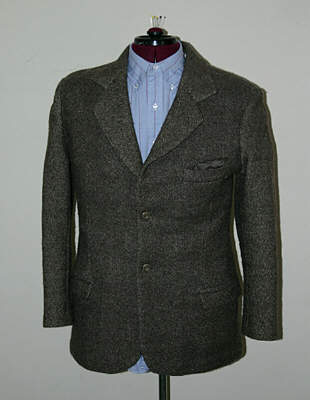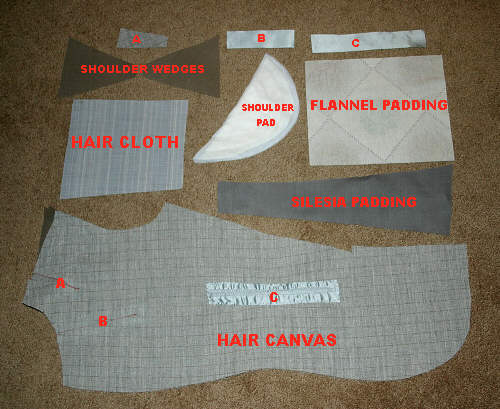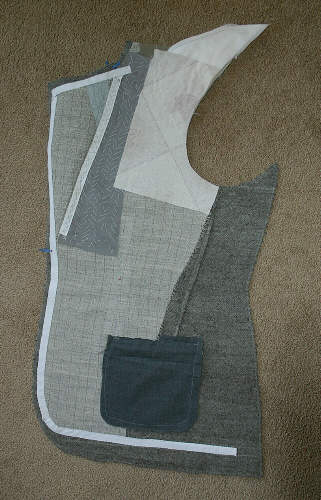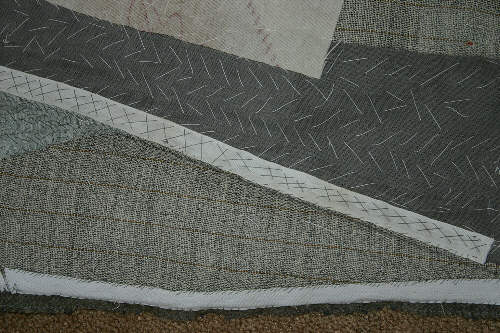TAILORING
Jack Schmidling Productions, Inc.
Marengo Illinois
MOST RECENT PHOTOS PHOTO INDEX HOME PAGE
New SLIDE SHOW New

TAILORING
Ever wonder why a well made gentleman's jacket looks so good on men who may not make much impression in a bathing suit?
Ever wonder what is inside one or why those who can afford them are willing to pay several thousand dollars for one?
I can't say that I ever did but after I decided that eating my sheep was out of the question, I found out the hard way. This jacket is my latest attempt at hand tailoring and was completed in Spring. I am now making another one and thought it would be interesting to show what goes into a tailored jacket.

These are some of the pieces that make up the "canvas" which is sandwiched between the lining and the garment fabric. The purpose of the canvas it to produce and hold the shape of the garment even if it is not exactly the shape of the wearer.
The foundation of the canvas is a large piece of fabric known as "hair canvas" that is cut to the shape of the front and then various locations are slashed and either pulled together or spread apart to provide the shaping.
The pieces A, B and C are stitched in front or behind the slits to hold them in the forced positions. A spreads the shoulder edge to provide the beautiful curve to the shoulder. B and C shape the chest and pinch the waist.
The shoulder wedges can be seen peeking out from under the bottom of the shoulder. These are also stretched and shaped to provide proper shoulder curve. They are cut from a fabric known a Belgian Linen which is a very coarse canvas, almost like window screen.

The haircloth goes over the chest area to provide extra shape and firmness. Both hair cloth and hair canvas contain hair from the manes and tails of horses. This makes them very pliable and easily shaped under steam pressure and it retains this shape after pressing. The difference between the two is the amount of hair in the fabric and the hair cloth has about 5 times as much hair.
You probably have heard of doing penance by wearing a "hairshirt". The hair is more like wire than thread and this makes the hairshirt most uncomfortable. We obviously do not want this in our tailored garments so it and all its exposed edges are covered with the flannel and silesia padding.
This photo also shows how the shoulder pad is installed between the canvas and the garment fabric. Real tailors make these themselves to properly fit each customer. I make mine from cotton batting sandwiched between two layers of light muslin.
The pocket is constructed on both sides of the garment front and tacked in a few places to the canvas for additional support. The inside pouch is made of a special cotton fabric known as silesia.
The roll line of the lapel is given shape by hand stitching a cotton tape along the inside edge of the roll line. The entire front and bottom of the jacket is taped in a similar manner to provide a crisp look after the facing is attached.

This picture provides some idea of the amount of hand stitching involved in preparation and attachment of the canvas. Much of it can not be seen because of the lack of contrast but every square inch of the canvas is covered with the chevron type basting stitches. The canvas and/or the jacket is held is curved positions while the stitching is done so that the curves remain for the life of the garment.
None of these stitches must be seen from the front of the jacket so for this reason and the curving, it can not be done by machine. This of course, is what makes hand tailored jackets so expensive. The labor involved is truly monumental.
I am glad it is only a hobby with me.
For more background on how I got into this, see FIBER CRAFTS
ASTRONOMY BEER CHEESE FIBER CRAFTS GEMS INSECTS PRESERVED FOOD SILVER VIDEO